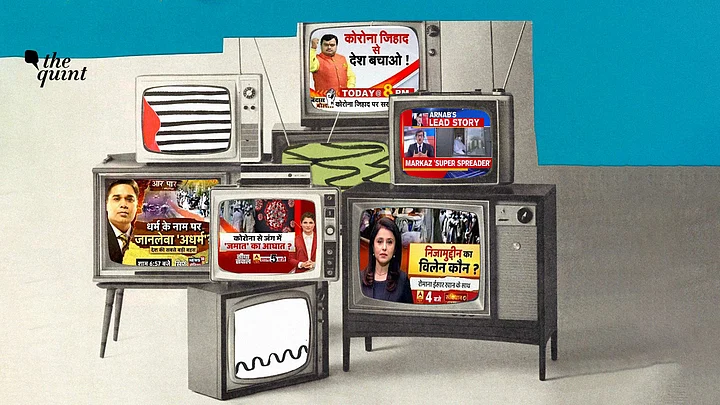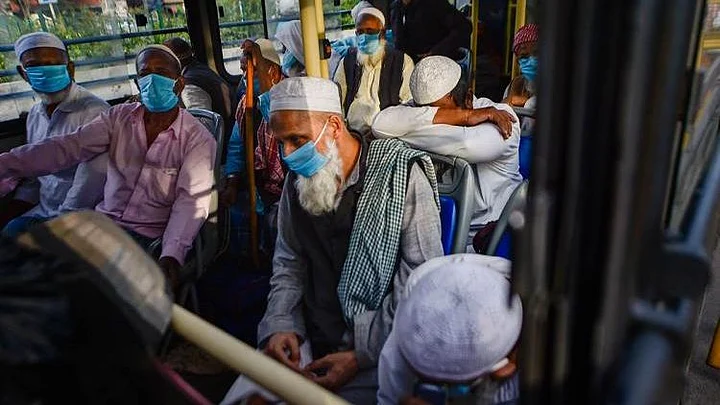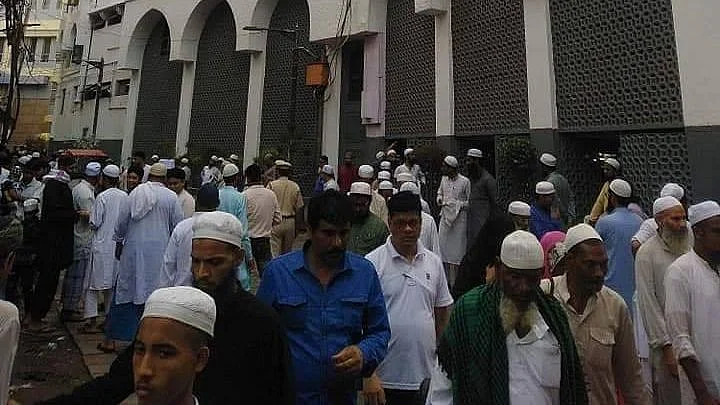Even by the standards of Arnab Goswami, the bullying messiah of manufactured outrage, it was nothing short of jaw-dropping. This week, the star anchor of Republic TV, who has made shouting at his studio guests the USP of his remarkable brand of journalism, was in conversation with some Muslim clerics in the wake of the rash of Covid-19 infections that has arisen from the Tablighi Jamaat congregation held in Delhi’s Markaz Nizamuddin in mid-March.
But I use the word 'conversation' loosely. A civilised conversation is rarely on the table when Goswami presides over prime time. And that night, he upped his game some more.
“Awaaz kam!” he roared suddenly. The person at whom this thundering command was directed was trying to say something in a fairly low voice. But Goswami took no notice of it. Excited by the gunshot crack of his utterance, he kept hollering “Awaaz kam!”, while shaking his fist fiercely. And in case anyone was confused as to why these people needed to be violently silenced, he added, “Desh bhar mein hahakaar phailake rakkha hai aap logon ne (You’ve created mayhem all over the country).”
- The Tablighi Jamaat congregation has had a disastrous impact on the spread of the coronavirus in India.
- But in reporting this catastrophic lapse the media seem to be focussed on one thing alone — unleashing a propaganda war against the orthodox Islamic religious body.
- Social media, too, took up the chorus, with hash tags such as #CoronaJihad and #JamaatiVirus trending for days.
- Unleashing divisiveness and internal strife has never been more counterproductive than now.
COVID-19 Masks Communal Propaganda of Electronic Media
The Tablighi Jamaat congregation has, of course, had a disastrous impact on the spread of the coronavirus in India. It has become a “super-spreader”, so far accounting for over 25 per cent of all COVID-19 cases India, including several deaths in Telangana and one in Kashmir.
To hold a religious meet with over 3000 participants, many of whom came from countries where the virus was already rampant, despite clear government advisories against big public gatherings, was a horrific display of irresponsibility. The Delhi police and the state government were also supremely negligent in allowing the congregation to take place, and hence must shoulder the blame as well.
But in reporting this catastrophic lapse on the part of both the Jamaat and the state authorities, the media, especially the electronic media, seem to be focussed on one thing alone — unleashing a propaganda war against the orthodox Islamic religious body.
Whether it is Republic TV or ABP News or Times Now or Aaj Tak or some of the other Hindi news channels, each has kept up a barrage of inflammatory invective against the Jamaat and its members, labelling their act as a “conspiracy” against the country, whipping up public anger against them, and, in effect, turning this huge public health fiasco into one more occasion to stoke Islamophobia.
Language of COVID-19 Spread Reporting
As always, Goswami, whose shows serve as vehicles at once for drumming up support for the government and spreading hate against its critics, led the virulent charge. “They have compromised us all, we were just winning when they did everything to defeat us," he ranted. "A conspiracy against India will have to be bought down with effectiveness.”
Others weren’t far behind. “Aadesho ki dhajiyan udayin, social distancing ka mazaak (They tore the orders to shreds and made a mockery of social distancing),” declared Aaj Tak’s Anjana Om Kashyap. “Markaz ne mamla bigaad diya (Markaz has spoilt the situation),” she fumed.
While Rubika Liyaquat of ABP News kept up a stream of angry rhetoric against the Jamaatis, Times Now carried headlines such as, “Now Tabilghis run amok”. Its anchor Navika Kumar railed, “They have begun to target our Covid warriors, doing all sorts of horrendous things which you and I cannot imagine… such an unruly lot!”
Can Social Media Be Far Behind?
Social media, too, took up the chorus, with hash tags such as #CoronaJihad and #JamaatiVirus trending for days. Unsubstantiated allegations that the quarantined Jamaat members were sexually harassing nurses, misbehaving with health workers and spitting on them were retweeted all around. Misinformation was rife on video sharing platform TikTok, too.
A report by India Today cited TikTok videos that were encouraging Muslims to believe that they were immune from the virus and could do as they pleased.
Needless to say, such dangerous videos also serve to infuriate many Hindus who fervently want to believe that a Muslim organisation ended up compromising India’s fight against the coronavirus.
There are older videos creating a perception that Muslims are deliberately sneezing and spitting to infect people in India. The Quint’s Webqoof section is full of fact-checks about their veracity.
To come back to the Tablighi Jamaat, no one disputes that what it did was inexcusable. Holding the meet was an act of criminal irresponsibility, for as the attendees fanned out all over the country, they have gone on to infect a large number of people, resulting in a sharp spike in the number of COVID-19 cases. There's no doubt that the law must hold the Tabligh leaders accountable for their irresponsible and foolish act.
Coronavirus Hotspot is Getting Weaponised
The media has every right — indeed, it must — report these facts. But here's the thing. It must also highlight the fact that many large religious places around the country, which are frequented daily by thousands of devotees, were open at the time when the Jamaat congregation took place in Delhi. Just as it must ensure the authenticity of the so-called spitting videos, and report the fact that spit attacks have become common around the world in the wake of the COVID-19 outbreak. It is an execrable act, since spitting on a person can infect him with a deadly virus, but it is certainly not exclusive to a particular group of people in India.
However, in the journalism of demagoguery practised by much of the media today, facts are routinely weaponised to drive an agenda. Facts are also twisted and used selectively. The coverage of the coronavirus hotspot of Tablighi Jamaat is no exception.
The nightly rants against the Tabligh on television channels are a concerted attempt to fuel a witch hunt against it, and by association, against the Muslim community as a whole. It is an attempt to communalise India’s fight against the coronavirus outbreak, to mine the seam of hate against Muslims that has been so efficiently mined in recent times. Let us not forget that a little more than a month ago, a vicious mob attack in northeast Delhi left many Muslims dead and many more homeless.
On Friday BJP chief JP Nadda appealed to his party workers to not communalise the fight against the coronavirus. Perhaps he should also have issued the same appeal to members of the media, many of whom serve as diligent proxies of the government.
The coronavirus is bigger than any community—no matter how brute its majority. To fight it, we need every hand on the deck. Unleashing divisiveness and internal strife has never been more counterproductive than now.
(Shuma Raha is a journalist and author based in Delhi. She tweets at @ShumaRaha. This is an opinion piece and the views expressed above are the author’s own. The Quint neither endorses nor is responsible for the same.)
(At The Quint, we question everything. Play an active role in shaping our journalism by becoming a member today.)




